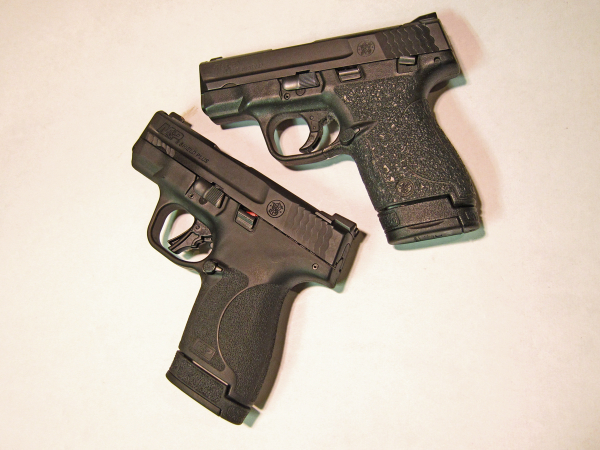
I was exposed to the Shield shortly after its introduction in 2012. I carried it regularly when extreme discretion forced me to give up the “15+1” auto loader I’d carried since 2001, competed with a loaner Shield in an IDPA Backup Gun National match at the S&W Academy and used it when traveling.
A second Shield arrived when they were going for rock-bottom low prices and about a million had been sold. I started the “Retail Shield” project here, working on evaluating a gun that arrived through retail channels. I’m wearing it now and it got considerable use in the run-up to and just after a serious medical procedure.
The S&W Shield is a very handy gun, reliable, accurate, light and flat. I’ve made extensive use of them. This use has made the gun a favorite of mine.
Slender, at less than an inch wide, the gun has a 7 + 1 capacity in 9mm, though I use it exclusively with S&W 8-shot magazines. I find the better grip more than offsets hiding the additional length. The “Retail Shield” is still stock, except for the Talon Grips I applied. I find the increased friction helps my compromised grip.
The Shield M2.0 I tried was fine, but I saw no need to move into the new line at that time. There were significant improvements in the M2.0, but I wasn’t moved to change … until now.
The heir to the Shield title is the Smith & Wesson Shield Plus. As the name implies, it’s a standard M2.0 with a new magazine – 10+1 flush-fit and a 13+1 (!) extended magazine. The gun shipped for evaluation had S&W night sights and no thumb safety. If you want the safety and night sights, get the standard gun and install the sights yourself.
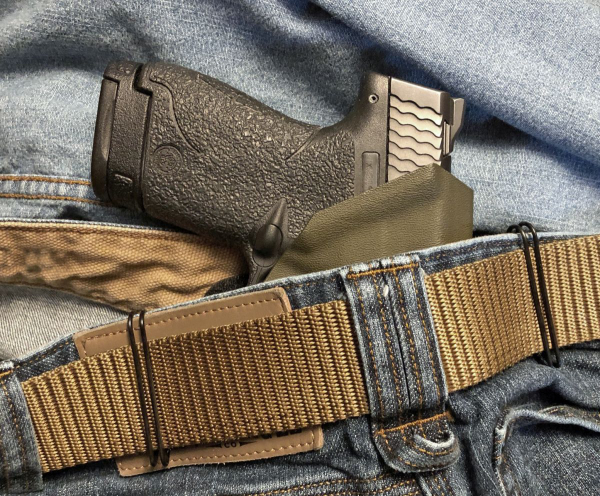
The slide and barrel of stainless steel, finished in “Armornite” are familiar. The gun, empty, seems to weigh a little less than the original article. Loaded, it’s heavier for reasons that should be obvious.
But how does it “feel?” It doesn’t – but we do. That question was answered at a local gun shop which received a Shield Plus before I did. In the short time they had it in their custody, I got the chance to handle it in the store.
If it was dark and I took the gun to hand, I couldn’t tell it was a 13+1 Shield Plus or a regular Shield M2.0 – until I felt the side of the trigger. Even then, I could well have concluded that it was a Shield with an after-market trigger.
Yep, they moved away from the curved, hinged trigger – that I actually liked – and went to a flat trigger with a flapper-trigger safety.
Otherwise, I couldn’t tell which was which by feel. If you’re okay with the handling of the Shield, the Shield Plus adds no apparent learning curve. That’s a welcome characteristic.
How did they cram all that ammo into that small a space? They went to a double-to-single stack magazine. As the cartridges feed down into the mag when loading, the magazine flares to a double stack width. They feed up into a single column, making the gun seem to be a slim, single stack 9mm.
What about aftermarket? As to sights, Meprolight introduced their Mepro Hyper-Bright sights for the Smith & Wesson Shield Plus here. Otherwise, it’s said that the Plus will fit Shield holsters. Magazine pouches are a different thing. I’ve been using the Pitbull Tactical Gen 2 Universal Mag Carriers. They’ve worked on everything I’ve tried so far – Shield and Shield Plus, Ruger MAX-9, Gen5 GLOCK 23 magazines – the works.
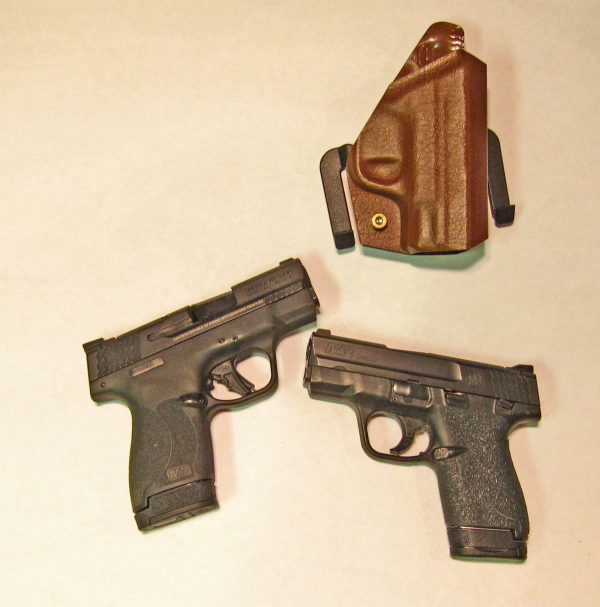
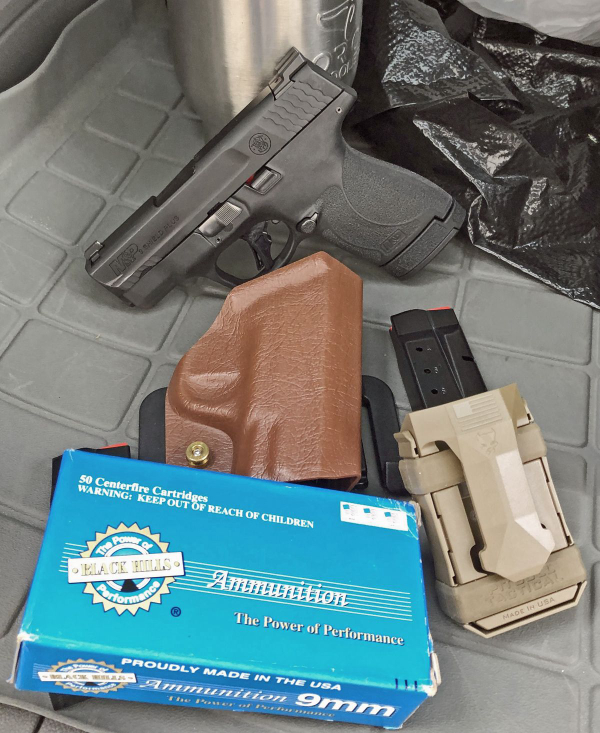
As to holsters, I saw the opportunity to try a newer design, one inspired by Dave Spaulding, Handgun Combatives. From Massaro Holster Works – I extensively carry the Retail Shield in the firm’s “American Purebred” IWB, as well as the Gen5 GLOCK 19 – there’s a new OWB design I’ve been itching to try. These holsters are part of the S.P.E.E.D. (Spaulding Enhanced EDC Design) lineup.
Featuring a “molded in” 12° cant, the gun is held close to the body. The flat holster back enhances comfort and “speed-ease” belt clips are quick “on-and-off,” while keeping the holster firmly attached to the belt. The holster furnished for the evaluation had a brown “leather-look” print, very fancy. Along with the “9mm retention adjustment screw,” it makes for a unique look.
I’d worn the new holster with the Retail Shield in the few days before the last of our LEOSA range outings of the year. As the Shield Plus had arrived, I elected to fire the first rounds out of the new gun on a qualifying run. No cleaning, no test firing, no checking zero, just shooting the gun.
I did try the trigger, dry, to see if I’d fail to deactivate the trigger safety – as I sometimes have on the Apex trigger on my original Shield or did at the outset of my use of the Ruger MAX-9. It didn’t seem to be a problem.
I showed up with some aged Black Hills 115 FMJ ‘remanufactured’ ammo – remember those days? – and the Pitbull Gen2 Universal Magazine pouches along with the Massaro S.P.E.E.D. holster and tried my luck.
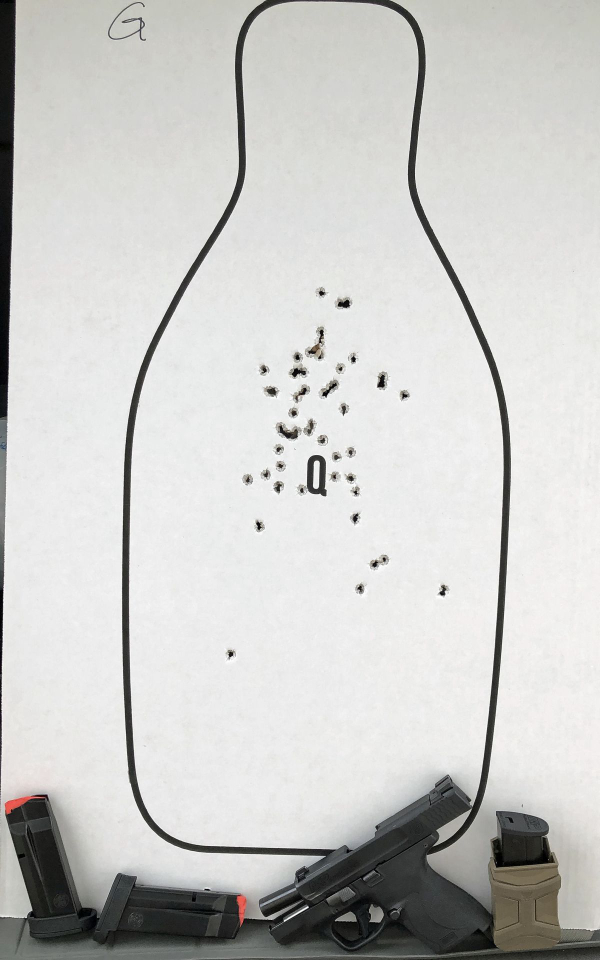
It’s only fifty rounds, but I had no malfunctions, the gun shot to the sights – those low hits are the pathetic effort of a geezer from 25 yards—and it was exactly like shooting the other Shields … except it seemed to take longer to shoot the gun dry.
The holster provided quick access, hence the name “S.P.E.E.D.,” it was comfortable and properly adjusted to the Shield Plus. This rig is terrific, not just for wearing concealed or for range work, but it’s handy for those situations where you have to disarm and secure your firearm before going into certain locations.
The sights are bright and sharp, the trigger firm and easily controlled. The texture is fine as is, though I’ve become accustomed to the Talon Grip – particularly the “Pro” granulation.
A 100% score and a good first range trip for a new iteration of a great gun. I hope it lasts the way the original guns did.
We’ll keep you posted.
-- Rich Grassi